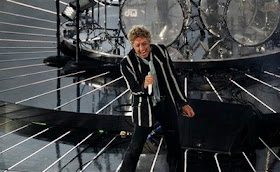
 We should be preparing for the grunge revival right about now, so what’s with the influx of bands during the past few years that seem to focus their gaze on the New Romantic glow of the early 80’s. More importantly, what’s with these bands actually doing it with more accuracy, intelligence, and hooks than, well, since the early 80’s.
We should be preparing for the grunge revival right about now, so what’s with the influx of bands during the past few years that seem to focus their gaze on the New Romantic glow of the early 80’s. More importantly, what’s with these bands actually doing it with more accuracy, intelligence, and hooks than, well, since the early 80’s.The Golden Silvers is yet another entry into the arena with limited guitars, layers of keyboards, and ass moving disco beats. These cats are so legit at their approach that it wouldn’t surprise me if they documented the making of True Romance on fucking Betamax.
For a trio, these Londoners have quite a complex pallet going on throughout their debut. Harmonies are effortless, melodies abound, and the lyrics are surprisingly refined. In “My Love Is A Seed That Doesn’t Grow,” frontman Gwilym Gold laments his relationship inadequacies with impressive metaphors, comparing the rush of love with a tsunami: “I turn within the tidal wave/to greet it face to face/but a burning, broken burning bridal veil/is there within its place.”
Yes, True Romance is named in irony as most of the subject matter is based in love lost, love forlorn, and love unrequited. But there are moments of playfulness: “Queen of the 21st Century” takes a swipe at the paparazzi culture, where every hair must be in place, and every piece of clothing sponsored by a brand-name designer. “Gonna make myself into a painting” Gold declares, “A masterpiece of lies that can pose.” It was written well before the incident, but I immediately visualized the emaciated Ralph Lauren Photoshop as of late. What begins as a playful character study suddenly turns dark at the end of the song, when the lead character realizes that he needs to “take my razor blade and carve away the years.” When the finality of his vanity is in sight and “the blade is blunt and won’t cut any deeper” Gold coldly deadpans that he’ll “push so hard that all I do is bleed…Gonna cut til there’s nothing left of me,” The morbid delivery then meets up with a three-part harmony of “Oooo oooo oooo” and the upbeat tempo resumes.
What’s missing from bands of similar nostalgia is the idea of a song-cycle within a full-length release. There are many bands of late that adequately capture the feel of the key tracks of their influences, while failing to examine how many of those bands also released some pretty complete albums too. For example: as good as ABC’s “Poison Arrow” or “The Look of Love” is, the album its housed on (The Lexicon of Love) is even better.
The Golden Silvers seem to understand this, and they’ve created a debut that’s filled with singular moments pancaked between album tracks of equally high caliber.
The result is that True Romance is not only one of the best pop albums you’ll hear all year, but one of the best offerings you’ll hear since the era it’s aligned to.
If bands like Golden Silvers can deliver records as good as this, then I have no problem if the guitars and flannel stay in storage for a few years longer.
This review originally appeared in Glorious Noise.
















